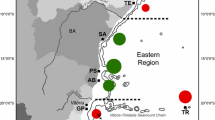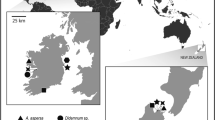Abstract
In a recent communication by Stat and Gates (Biol Invasions 10: 579–583, 2008), discovery of a symbiotic combination involving the coral Acropora cytherea and the dinoflagellate endosymbiont, Symbiodinium A1 (Symbiodinium microadriaticum, Freudenthal sensu stricto) in the Northwest Hawaiian Islands was interpreted to be the result of a ‘recent’ introduction. While introductions of symbiotic dinoflagellates have occurred and are occurring, the authors’ conclusion was made without sufficient information about the geographic range and host specificity exhibited by A1. The only direct genetic analysis of symbionts from the putative host vector, a jellyfish in the genus Cassiopeia sp., from Kaneohe Bay on the Island of Oahu, found that it contained a different symbiont species, A3. Furthermore, Stat and Gates (Biol Invasions 10: 579–583, 2008) did not consider the importance of host-symbiont specificity in preventing the establishment of a foreign symbiont species. In comparison to A. cytherea, A. longicyathus on the southern most Great Barrier Reef also hosts Symbiodinium A1 and a closely related endemic, A1a. Instead of assuming that A. cytherea has an unnatural association, a practical explanation is that long-term ecological and evolutionary processes influenced by local environments underlie the unusual, but not unprecedented finding of a Pacific acroporid associating with Clade A Symbiodinium spp.


Similar content being viewed by others
References
Baillie BK, Baillie CB, Maruyama T (2000) Conspecificity and Indo-Pacific distribution of Symbiodinium genotypes (dinophyceae) from giant clams. J Phycol 36:1153–1161
Baker AC (2003) Flexibility and specificity in coral-algal symbiosis: diversity, ecology and biogeography of Symbiodinium. Annu Rev Ecol Evol Syst 34:661–689. doi:10.1146/annurev.ecolsys.34.011802.132417
Baker AC, Starger CJ, McClanahan TR, Glynn PW (2004) Corals’ adaptive response to climatechange. Nature 430:741. doi:10.1038/430741a
Barneah O, Brickner I, Hooge M, Weis VM, LaJeunesse TC, Benayahu Y (2007) Three party symbiosis: acoelomorph worms, corals and unicellular algal symbionts in Eilat (Red Sea). Mar Biol 151:1215–1223. doi:10.1007/s00227-006-0563-2
Carlton J, Geller B (1993) Ecological roulette: the global transport of non-indigenous marine organisms. Science 261:78–82. doi:10.1126/science.261.5117.78
Coffroth MA, Santos SR (2005) Genetic diversity of symbiotic dinoflagellates in the genus Symbiodinium. Protist 156:19–34. doi:10.1016/j.protis.2005.02.004
Coffroth MA, Santos SR, Goulet TL (2001) Early ontogenetic expression of specificity in a cnidarian-algal symbiosis. Mar Ecol Prog Ser 222:85–96. doi:10.3354/meps222085
Darius HT, Martin PM, Grimont PAD, Dauga C (2000) Small subunit rDNA sequence analysis of symbiotic dinoflagellates from seven scleractinian corals in a Tahitian lagoon. J Phycol 36:951–959. doi:10.1046/j.1529-8817.2000.99088.x
Fitt WK, Brown BE, Warner ME, Dunne RP (2001) Coral bleaching: interpretation of thermal tolerance limits and thermal thresholds in tropical corals. Coral Reefs 20:51–65. doi:10.1007/s003380100146
Freudenthal HD (1962) Symbiodinium gen. nov. and Symbiodinium microadriaticum sp. nov., a zooxanthella: Taxonomy, life cycle and morphology. J Protozool 9:45–52
Goulet TL (2006) Most corals may not change their symbionts. Mar Ecol Prog Ser 321:1–7. doi:10.3354/meps321001
Goulet TL, Coffroth MA (2003) Stability of an octocoral-algal symbiosis over time and space. Mar Ecol Prog Ser 250:117–124. doi:10.3354/meps250117
Graham WM, Martin DL, Felder DL, Asper VL, Perry HM (2003) Ecological and economic implications of a tropical jellyfish invader in the Gulf of Mexico. Biol Invasions 5:53–69. doi:10.1023/A:1024046707234
Hoegh-Guldberg O (1999) Climate change, coral bleaching and the future of the world’s coral reefs. Mar Freshw Res 50:839–866. doi:10.1071/MF99078
Holland B, Dawson M, Crow G, Hofmann D (2004) Global phylogeography of Cassiopea (Scyphozoa: Rhizostomeae): molecular evidence for cryptic species and multiple invasions of the Hawaiian Islands. Mar Biol (Berl) 145:119–1128. doi:10.1007/s00227-004-1409-4
IPCC (2007) Climate Change 2007: synthesis report. Contribution of working groups I, II, and III to the fourth assessment report of the Intergovernmental Panel on Climate Change (Core writing team, Pachauri RK, Reisinger A (eds.)). IPCC, Geneva, Switzerland, 104 pp
LaJeunesse TC (2001) Investigating the biodiversity, ecology, and phylogeny of endosymbiotic dinoflagellates in the genus Symbiodinium using the ITS region: In search of a “species” level marker. J Phycol 37:866–880. doi:10.1046/j.1529-8817.2001.01031.x
LaJeunesse TC (2002) Diversity and community structure of symbiotic dinoflagellates from Caribbean coral reefs. Mar Biol (Berl) 141:387–400. doi:10.1007/s00227-002-0829-2
LaJeunesse TC (2004) “Species” radiations of symbiotic dinoflagellates in the Atlantic and Indo-Pacific since the Miocene-Pliocene transition. Mol Biol Evol 22:570–581. doi:10.1093/molbev/msi042
LaJeunesse TC, Trench RK (2000) The biogeography of two species of Symbiodinium (Freudenthal) inhabiting the intertidal anemone, Anthopleura elegantissima (Brandt). Biol Bull 199:126–134. doi:10.2307/1542872
LaJeunesse TC, Pinzón JH (2007) Screening intragenomic rDNA for dominant variants can provide a consistant retrieval of evolutionarily persistent ITS (rDNA) sequences. Mol Phylogenet Evol 45:417–422. doi:10.1016/j.ympev.2007.06.017
LaJeunesse TC, Loh WKW, van Woesik R, Hoegh-Guldberg O, Schmidt GW, Fitt WK (2003) Low symbiont diversity in southern Great Barrier Reef corals relative to those of the Caribbean. Limnol Oceanogr 48:2046–2054
LaJeunesse TC, Bhagooli R, Hidaka M, Done T, de Vantier L, Schmidt GW et al (2004a) Closely-related Symbiodinium spp. differ in relative dominance within coral reef host communities across environmental, latitudinal, and biogeographic gradients. Mar Ecol Prog Ser 284:147–161. doi:10.3354/meps284147
LaJeunesse TC, Thornhill DJ, Cox E, Stanton F, Fitt WK, Schmidt GW (2004b) High diversity and host specificity observed among symbiotic dinoflagellates in reef coral communities from Hawaii. Coral Reefs 23:596–603
LaJeunesse TC, Lee S, Bush S, Bruno JF (2005) Persistence of non-Caribbean algal symbionts in Indo-Pacific mushroom corals released to Jamaica 35 years ago. Coral Reefs 24:157–159. doi:10.1007/s00338-004-0436-4
LaJeunesse TC, Reyes-Bonilla H, Warner ME, Wills M, Schmidt GW, Fitt WK (2008) Specificity and stability in high latitude eastern Pacific coral-algal symbioses. Limnol Oceanogr 53:719–727
Loh WK, Carter D, Hoegh-Guldberg O (1998) Diversity of Zooxanthellae from Scleractinian Corals of One Tree Island (The Great Barrier Reef). In: Greenwood JG, Hall NJ (eds) Proceedings of the Australian coral reef Society 75th anniversary conference, Heron Island, pp 141–150
Loh WK, Loi T, Carter D, Hoegh-Guldberg O (2001) Genetic variability of the symbiotic dinoflagellates from the wide ranging coral species Seriatopora hystrix and Acropora longicyathus in the Indo-West Pacific. Mar Ecol Prog Ser 222:97–107. doi:10.3354/meps222097
Gomez-Cabrera MdC (2005) Some aspects of the physiology and ecology of the Acropora longicyatus multi-cladal symbiosis. Ph.D. Thesis, The University of Queensland, 165 pp
Mostafavi PG, Fatemi SMR, Shahhosseiny MH, Hoegh-Guldberg O, Loh WKW (2007) Predominance of clade D Symbiodinium in shallow-water reef-building corals off Kish and Larak Islands (Persian Gulf, Iran). Mar Biol (Berl) 153:25–34. doi:10.1007/s00227-007-0796-8
Pettay T, LaJeunesse TC (2007) Microsatellites from clade B Symbiodinium spp. specialized for Caribbean corals in the Genus Madracis. Mol Ecol Notes 7:1271–1274. doi:10.1111/j.1471-8286.2007.01852.x
Pimentel D (2002) Biological invasions: economic and environmental costs of alien plant, animal, and microbe species. CRC Press, Washington DC, p 384
Pochon X, LaJeunesse TC, Pawlowski J (2004) Biogeographic partitioning and host specialization among foraminiferan dinoflagellate symbionts (Symbiodinium, Dinophyta). Mar Biol (Berl) 146:17–27. doi:10.1007/s00227-004-1427-2
Rodriquez-Lanetty M, Loh W, Carter D, Hoegh-Guldberg O (2001) Latitudinal variability in symbiont specificity within the widespread scleractinian coral Plesiastrea versipora. Mar Biol (Berl) 138:1175–1181. doi:10.1007/s002270100536
Rodriquez-Lanetty M, Chang S-J, Song JI (2003) Specificity of two temperate dinoflagellate-anthozoan associations from the north-western Pacific Ocean. Mar Biol (Berl) 143:1193–1199. doi:10.1007/s00227-003-1165-x
Rowan R, Powers DA (1991) A molecular genetic classification of zooxanthellae and the evolution of animal-algal symbiosis. Science 251:1348–1351. doi:10.1126/science.251.4999.1348
Ruiz G, Carlton J, Grohlz E, Hines A (1997) Global invasions of marine estuarine habitats by non-indigenous species: mechanisms, extent and consequences. Am Zool 37:621–632
Santos SR, Taylor DJ, Coffroth MA (2001) Genetic comparisons of freshly isolated vs. cultured symbiotic dinoflagellates: implications for extrapolating to the intact symbiosis. J Phycol 37:900–912. doi:10.1046/j.1529-8817.2001.00194.x
Santos S, Taylor DJ, Kinzie RAIII, Hidaka M, Sakai K, Coffroth MA (2002) Molecular phylogeny of symbiotic dinoflagellates inferred from partial chloroplast large subunit (23S)-rDNA sequences. Mol Phylogenet Evol 23:97–111. doi:10.1016/S1055-7903(02)00010-6
Santos SR, Shearer TL, Hannes AR, Coffroth MA (2004) Fine-scale diversity and specificity in the most prevalent lineage of symbiotic dinoflagellates (Symbiodinium, Dinophyceae) of the Caribbean. Mol Ecol 13:459–469. doi:10.1046/j.1365-294X.2003.02058.x
Schonberg CHL, Loh WKW (2005) Molecular identity of the unique symbiotic dinoflagellates found in the bioeroding demosponge Cliona orientalis. Mar Ecol Prog Ser 299:157–166. doi:10.3354/meps299157
Seutin G, White BN, Boag PT (1991) Preservation of avian blood and tissue samples for DNA analyses. Can J Zool 69:82–92. doi:10.1139/z91-013
Shick MJ (2004) The continuity and intensity of ultraviolet irradiation affect the kinetics of biosynthesis accumulation, and conservation of mycosporine-like amino acids (MAAs) in the coral Stylophora pistillata. Limnol Oceanogr 49:442–458
Stat M, Gates RD (2008) Vectored introductions of marine endosymbiotic dinoflagellates into Hawaii. Biol Invasions 10:579–583. doi:10.1007/s10530-007-9167-0
Stimson J, Sakai K, Sembali H (2002) Interspecific comparison of the symbiotic relationship in corals with high and low rates of beaching-induced mortality. Coral Reefs 21:409–421
Swofford DL (2000) PAUP, phylogenetic analysis using parsimony Version 4.0b10. Sinauer, Sunderland
Thompson JN (1999) Specific hypotheses on the geographic mosaic of coevolution. Am Nat 153:S1–S14. doi:10.1086/303208
Thornhill DJ, Fitt WK, Schmidt GW (2006a) Highly stable symbioses among western Atlantic brooding corals. Coral Reefs 25:515–519. doi:10.1007/s00338-006-0157-y
Thornhill DJ, LaJeunesse TC, Kemp DW, Fitt WK, Schmidt GW (2006b) Multi-year, seasonal genotypic surveys of coral-algal symbioses reveal prevalent stability or post-bleaching reversion. Mar Biol (Berl) 148:711–722. doi:10.1007/s00227-005-0114-2
Thornhill DJ, LaJeunesse TC, Santos SR (2007) Measuring rDNA diversity in eukaryotic microbial systems: How intragenomic variation, pseudogenes, and PCR artifacts confound biodiversity estimates. Mol Ecol 16:5326–5340
Titlyanov EA, Titlyanov TV, Leletkin VA, Tsukahara J, van Woesik R, Yamazato K (1996) Degradation of zooxanthellae and regulation of their density in hermatypic corals. Mar Ecol Prog Ser 139:167–178. doi:10.3354/meps139167
Toller WW, Rowan R, Knowlton N (2001) Zooxanthellae of the Montastraea annularis species complex: Patterns of distribution of four taxa of Symbiodinium on different reefs and across depths. Biol Bull 201:348–359. doi:10.2307/1543613
Trench RK, Blank RJ (1987) Symbiodinium microadriaticum Freudenthal, S. goreauii sp. nov., S. kawagutii sp. nov. and S. pilosum sp. nov.: Gymnodinioid dinoflagellate symbionts of marine invertebrates. J Phycol 23:469–481. doi:10.1111/j.1529-8817.1987.tb02534.x
Van Oppen MJH, Palstra FP, Piquet AM-T, Miller DJ (2001) Patterns of coral-dinoflagellate associations in Acropora: significance of local availability and physiology of Symbiodinium strains and host-symbiont selectivity. Proc R Soc Lond B Biol Sci 268:1759–1767. doi:10.1098/rspb.2001.1733
Acknowledgements
Thanks to D. Tye Pettay (Penn State) for bringing the Stat and Gates paper to our attention and to Maria del Carmen Gomez-Cabrera (University of Queensland) for sending her dissertation on Acropora longicyathus symbioses. Scott Santos (Auburn University) provided helpful comments. This work was funded by Pennsylvania State University.
Author information
Authors and Affiliations
Corresponding author
Rights and permissions
About this article
Cite this article
LaJeunesse, T.C., Loh, W. & Trench, R.K. Do introduced endosymbiotic dinoflagellates ‘take’ to new hosts?. Biol Invasions 11, 995–1003 (2009). https://doi.org/10.1007/s10530-008-9311-5
Received:
Accepted:
Published:
Issue Date:
DOI: https://doi.org/10.1007/s10530-008-9311-5




